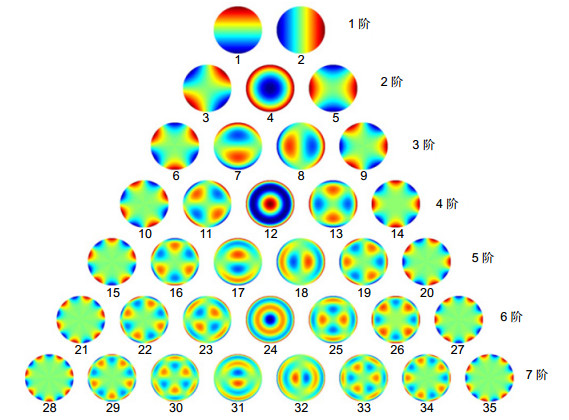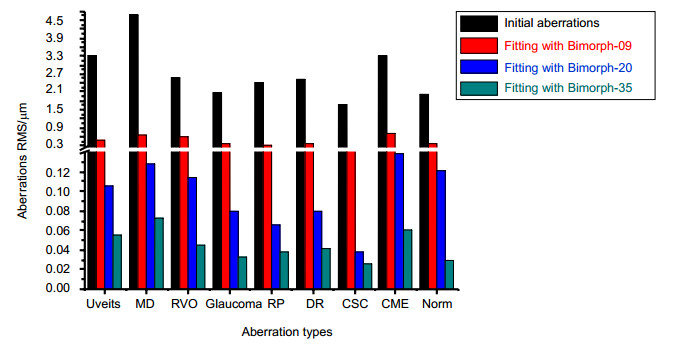-
摘要
针对三种不同空间分辨率的双压电片变形镜(Bimorph DM),采用仿真实验分析其对3~35项Zernike静态像差和实际人眼(包括疾病人眼)像差的拟合能力。实验表明,Bimorph变形镜特别适用于校正低阶像差,拟合误差小于0.15,随着空间分辨率的增加,Bimorph变形镜对Zernike像差和人眼像差的拟合能力总体表现为增强的趋势,其中,35单元的Bimorph变形镜的像差拟合能力最优,对前20项Zernike像差的拟合误差稍优于传统分立式压电变形镜。通过对Bimorph变形镜像差拟合能力的实验分析,为人眼视网膜高分辨率系统的Bimorph变形镜选型提供了分析方法,也为进一步提升Bimorph变形镜的像差校正能力奠定了研究基础。

Abstract
This study adapted simulations to analyze the fitting capabilities to human aberration of three kinds of Bimorph Deformable Mirrors (DMs) with different spatial resolutions, especially the capability to fit to 3~ 35th orders of Zernike static aberrations and the human aberrations, including the eye of diseases. It's shown that Bimorph DM is well suitable for fitting to low-order aberrations with the error less than 0.15. As the spatial resolution increased, the capability of fitting aberrations enhanced totally. Compared with traditional discrete piezoelectric DM, 35-element Bimorph DM had smaller fitting error on the first 20th Zernike aberration. This simulated analysis provided an analytical method for the selection of Bimorph DMs for high-resolution human eye imaging systems. In addition, it provided a research foundation of further improvement of the Bimorph DM in fitting aberrations capability.
-
Overview

Overview: For the three kinds of bimorph deformable mirrors (DM) with different spatial resolutions developed by the Institute of Optics and electronics, CAS, a numerical simulation is used to analyze the fitting ability of 3~35 Zernike static aberration firstly in this article. The numerical results shown that all those Bimorph DMs have a certain ability to correct the Zernike static aberrations and perform well for the correction of low-order aberrations particularly. With the increase of the spatial resolution of the Bimorph DM, the aberration fitting capability appeared to increase as well. According to the limitation to 15% of the normalized error of the Zernike aberration fitting, there are 3 items of Zernike aberrations which can be fitting well by Bimorph-9, and 7 items by Bimorph-20, and 14 items by Bimorph-35; Therefore, Bimorph-35 DM with the highest spatial resolution has the strongest aberration correction ability among the three kinds of Bimorph DMs. Next, we analyzed the aberration correction of the human eyes (including the diseased eyes) and found that three kinds of Bimorph DMs have a certain ability to correct aberrations in human eyes with different types of diseases. The Bimorph-9 DM didn't correct human eye aberration obviously, and Bimorph-35 has the strongest aberration correction ability for human eye aberrations, nearly reaching to the diffraction limit (λ/14). Therefore, the Bimorph DM is one kind of feasible wavefront correctors for high-resolution imaging of human retina through the aberration fitting analysis of Bimorph DMs, especially for human eye aberrations fitting analysis. The Bimorph DM has the advantage of high precision in fitting low-order aberrations. Compared to the conventional discrete piezoelectric DM, the Bimorph-35 DM has a better fitting precision except for the 31~33 item of Zernike aberrations, especially for the first 20 Zernike aberrations. In conclusion, if only a single Bimorph DM is used to correct human eye aberrations, the Bimorph-35 DM is the best choice. In the future, the spatial resolution of Bimorph-35 DM can be further improved by reducing the optics aperture, reducing the size of the driving electrode, and adding an independent defocusing electrode layer to improve the fitting ability of the rotation symmetry aberration. If double DMs are used to correct the human eye aberrations, the combination of the Bimorph-9 and the discrete piezoelectric DM is an optimal choice, with the simplest structure, low cost, high stability and large stroke for the Bimorph-9 DM.
-

-
表 1 三种Bimorph变形镜参数
Table 1. Parameters of three types of Bimorph DMs
型号 驱动电极数目 最大行程量/μm 初始面形RMS值/nm 动态响应频率/kHz Bimorph-9 9 ±14 25 2^8 Bimorph-20 20 ±20 < 20 4 Bimorph-35 35 ±17 13 >3 -
参考文献
[1] 姜文汉.光电技术研究所的自适应光学技术[J].光电工程, 1995, 22(1): 1-13. http://www.cnki.com.cn/Article/CJFDTotal-GDGC501.000.htm
Jiang W H. Adaptive optics techniques investigations in institute of optics and electronics[J]. Opto-Electronic Engineering, 1995, 22(1): 1-13. http://www.cnki.com.cn/Article/CJFDTotal-GDGC501.000.htm
[2] 饶长辉, 朱磊, 张兰强, 等.太阳自适应光学技术进展[J].光电工程, 2018, 45(3): 170733. 10.12086/oee.2018.170733
Rao C H, Zhu L, Zhang L Q, et al. Development of solar adaptive optics[J]. Opto-Electronic Engineering, 2018, 45(3): 170733. 10.12086/oee.2018.170733
[3] Liang J Z, Williams D R, Miller D T. Supernormal vision and high-resolution retinal imaging through adaptive optics[J]. Journal of the Optical Society of America A, 1997, 14(11): 2884-2892. doi: 10.1364/JOSAA.14.002884
[4] 戴云, 肖飞, 赵军磊, 等.自适应光学人眼像差调控及其应用[J].光电工程, 2018, 45(3): 170703. 10.12086/oee.2018.170703
Dai Y, Xiao F, Zhao J L, et al. Ocular aberrations manipulation with adaptive optics and its application[J]. Opto-Electronic Engineering, 2018, 45(3): 170703. 10.12086/oee.2018.170703
[5] He Y, Wang Z B, Wang Y Y, et al. In vivo imaging of mice auricle vessels using adaptive optical confocal fluorescence microscope[J]. Chinese Optics Letters, 2015, 13(11): 111702. doi: 10.3788/COL http://www.cqvip.com/QK/85954X/201511/71887566504849534949484954.html
[6] Wang Y Y, He Y, Wei L, et al. Bimorph deformable mirror based adaptive optics scanning laser ophthalmoscope for retina imaging in vivo[J]. Chinese Optics Letters, 2017, 15(12): 121102. doi: 10.3788/COL
[7] 姜文汉.自适应光学发展综述[J].光电工程, 2018, 45(3): 170489. 10.12086/oee.2018.170489
Jiang W H. Overview of adaptive optics development[J]. Opto-Electronic Engineering, 2018, 45(3): 170489. 10.12086/oee.2018.170489
[8] Wang Z B, Wei D, Wei L, et al. Aberration correction during real time in vivo imaging of bone marrow with sensorless adaptive optics confocal microscope[J]. Journal of Biomedical Optics, 2014, 19(8): 086009. doi: 10.1117/1.JBO.19.8.086009
[9] Zhang Y H, Poonja S, Roorda A. MEMS-based adaptive optics scanning laser ophthalmoscopy[J]. Optics Letters, 2006, 31(9): 1268-1270. doi: 10.1364/OL.31.001268
[10] Liang J Z, Williams D R. Aberrations and retinal image quality of the normal human eye[J]. Journal of the Optical Society of America A, 1997, 14(11): 2873-2883. doi: 10.1364/JOSAA.14.002873
[11] Ning Y, Jiang W H, Ling N, et al. Response function calculation and sensitivity comparison analysis of various bimorph deformable mirrors[J]. Optics Express, 2007, 15(19): 12030-12038. doi: 10.1364/OE.15.012030
[12] Dai Y, Zhao L N, Xiao F, et al. Adaptive optics vision simulation and perceptual learning system based on a 35-element bimorph deformable mirror[J]. Applied Optics, 2015, 54(5): 979-985. doi: 10.1364/AO.54.000979
[13] Thibos L N, Applegate R A, Schwiegerling J T, et al. Standards for reporting the optical aberrations of eyes[J]. Journal of Refractive Surgery, 2002, 18(5): S652-S660. http://www.ncbi.nlm.nih.gov/pubmed/12361175
[14] Thibos L, Applegate R A, Schwiegerling J T, et al. Standards for reporting the optical aberrations of eyes[M]//Lakshminarayanan V. Vision Science and Its Applications. Santa Fe, New Mexico United States: Optical Society of America, 2000: 232-244.
[15] 周虹, 官春林, 戴云.用于自适应光学视网膜成像系统的双压电片变形反射镜[J].光学学报, 2013, 33(2): 0211001. http://www.wanfangdata.com.cn/details/detail.do?_type=perio&id=QKV20132013051600112469
Zhou H, Guan C L, Dai Y. Bimorph deformable mirrors for adaptive optics of human retinal imaging system[J]. Acta Optica Sinica, 2013, 33(2): 0211001 http://www.wanfangdata.com.cn/details/detail.do?_type=perio&id=QKV20132013051600112469
-
访问统计


 E-mail Alert
E-mail Alert RSS
RSS

 下载:
下载:






